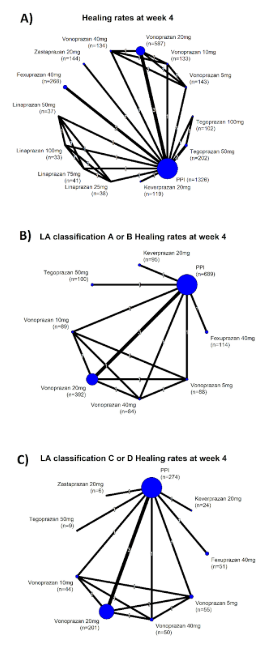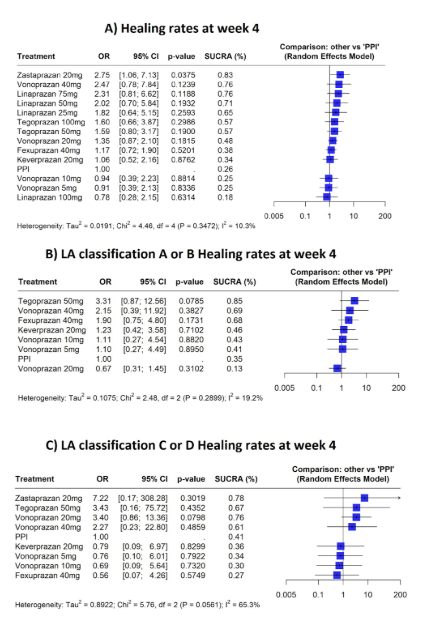Monday Poster Session
Category: Esophagus
P2806 - Four-Week Healing Rates of Erosive Esophagitis: A Network Meta-Analysis of P-CABs versus PPIs
Monday, October 27, 2025
10:30 AM - 4:00 PM PDT
Location: Exhibit Hall
.jpg)
Bisher Sawaf, MD (he/him/his)
University of Toledo Medical Center
Toledo, OH
Presenting Author(s)
Mulham Alom, MD1, Bisher Sawaf, MD2, Shahem Abbarh, MD3, Yusuf Omar Hallak, MD4, Amine Rakab, MD5, Ahmad Kasem, MSc6, Mohammed S. Beshr, MBBS7, Muhammed Elhadi, MD8
1Internal Medicine, Southern Illinois University School of Medicine, Springfield, IL; 2University of Toledo Medical Center, Toledo, OH; 3Georgetown University MedStar Health, Baltimore, WA; 4The University of Toledo, Toledo, OH; 5Division of Medical Education, Weill Cornell Medicine, Doha, Ad Dawhah, Qatar; 6David Geffen School of Medicine at UCLA, Los Angeles, CA; 7Sana’a University, Faculty of Medicine and Health Sciences, Sana'a, Hadramawt, Yemen; 8College of Medicine, Korea University, Seongbuk, Seoul-t'ukpyolsi, Republic of Korea
Introduction: Proton pump inhibitors (PPIs) have long been the cornerstone of treatment for erosive esophagitis (EE), but potassium-competitive acid blockers (P-CABs) have emerged as a promising alternative with faster onset and longer acid suppression. However, the comparative efficacy of individual P-CAB agents remains unclear. This network meta-analysis aimed to evaluate and compare the healing efficacy of various P-CABs and PPIs in EE, with subgroup analysis based on Los Angeles (LA) classification.
Methods: A systematic search was performed across PubMed, Embase, Scopus, Web of Science, and ClinicalTrials.gov up to May 2025. Randomized controlled trials (RCTs) evaluating healing rates of EE with P-CABs versus PPIs were included. The primary outcome was the 4-week healing rate. Patients were stratified based on LA grades A/B versus C/D. Odds ratios (OR) with 95% confidence intervals (CI) were calculated for each agent using a random-effects network meta-analysis model.
Results: Twelve trials involving 4,263 patients evaluated 4-week healing rates in erosive esophagitis. Treatments included vonoprazan (32.8%), tegoprazan (9.1%), fexuprazan (5.9%), keverprazan (2.5%), zastaprazan (3.1%), linaprazan (4.2%), and PPIs (42.5%). Most patients (73.2%) had LA grade A or B esophagitis, while 26.8% had grade C or D. Only zastaprazan 20 mg demonstrated a statistically significant improvement in the overall healing rate compared to PPIs (OR: 2.75, 95% CI: 1.06 to 7.13). However, no statistically significant differences were observed between any of the drug arms and PPIs in patients with LA grade A/B or LA grade C/D esophagitis.
Discussion: Zastaprazan 20 mg showed superior efficacy in the overall 4-week healing rate compared to PPIs, but no clear advantage was seen for any agent within specific LA grade subgroups. These findings suggest that while certain P-CABs may offer benefits over PPIs, their efficacy may not significantly differ in early versus advanced erosive esophagitis. Further head-to-head trials are warranted to better define optimal therapeutic choices across different severities of EE.

Figure: EE Figures

Figure: EE Forest plots
Disclosures:
Mulham Alom indicated no relevant financial relationships.
Bisher Sawaf indicated no relevant financial relationships.
Shahem Abbarh indicated no relevant financial relationships.
Yusuf Omar Hallak indicated no relevant financial relationships.
Amine Rakab indicated no relevant financial relationships.
Ahmad Kasem indicated no relevant financial relationships.
Mohammed Beshr indicated no relevant financial relationships.
Muhammed Elhadi indicated no relevant financial relationships.
Mulham Alom, MD1, Bisher Sawaf, MD2, Shahem Abbarh, MD3, Yusuf Omar Hallak, MD4, Amine Rakab, MD5, Ahmad Kasem, MSc6, Mohammed S. Beshr, MBBS7, Muhammed Elhadi, MD8. P2806 - Four-Week Healing Rates of Erosive Esophagitis: A Network Meta-Analysis of P-CABs versus PPIs, ACG 2025 Annual Scientific Meeting Abstracts. Phoenix, AZ: American College of Gastroenterology.
1Internal Medicine, Southern Illinois University School of Medicine, Springfield, IL; 2University of Toledo Medical Center, Toledo, OH; 3Georgetown University MedStar Health, Baltimore, WA; 4The University of Toledo, Toledo, OH; 5Division of Medical Education, Weill Cornell Medicine, Doha, Ad Dawhah, Qatar; 6David Geffen School of Medicine at UCLA, Los Angeles, CA; 7Sana’a University, Faculty of Medicine and Health Sciences, Sana'a, Hadramawt, Yemen; 8College of Medicine, Korea University, Seongbuk, Seoul-t'ukpyolsi, Republic of Korea
Introduction: Proton pump inhibitors (PPIs) have long been the cornerstone of treatment for erosive esophagitis (EE), but potassium-competitive acid blockers (P-CABs) have emerged as a promising alternative with faster onset and longer acid suppression. However, the comparative efficacy of individual P-CAB agents remains unclear. This network meta-analysis aimed to evaluate and compare the healing efficacy of various P-CABs and PPIs in EE, with subgroup analysis based on Los Angeles (LA) classification.
Methods: A systematic search was performed across PubMed, Embase, Scopus, Web of Science, and ClinicalTrials.gov up to May 2025. Randomized controlled trials (RCTs) evaluating healing rates of EE with P-CABs versus PPIs were included. The primary outcome was the 4-week healing rate. Patients were stratified based on LA grades A/B versus C/D. Odds ratios (OR) with 95% confidence intervals (CI) were calculated for each agent using a random-effects network meta-analysis model.
Results: Twelve trials involving 4,263 patients evaluated 4-week healing rates in erosive esophagitis. Treatments included vonoprazan (32.8%), tegoprazan (9.1%), fexuprazan (5.9%), keverprazan (2.5%), zastaprazan (3.1%), linaprazan (4.2%), and PPIs (42.5%). Most patients (73.2%) had LA grade A or B esophagitis, while 26.8% had grade C or D. Only zastaprazan 20 mg demonstrated a statistically significant improvement in the overall healing rate compared to PPIs (OR: 2.75, 95% CI: 1.06 to 7.13). However, no statistically significant differences were observed between any of the drug arms and PPIs in patients with LA grade A/B or LA grade C/D esophagitis.
Discussion: Zastaprazan 20 mg showed superior efficacy in the overall 4-week healing rate compared to PPIs, but no clear advantage was seen for any agent within specific LA grade subgroups. These findings suggest that while certain P-CABs may offer benefits over PPIs, their efficacy may not significantly differ in early versus advanced erosive esophagitis. Further head-to-head trials are warranted to better define optimal therapeutic choices across different severities of EE.

Figure: EE Figures

Figure: EE Forest plots
Disclosures:
Mulham Alom indicated no relevant financial relationships.
Bisher Sawaf indicated no relevant financial relationships.
Shahem Abbarh indicated no relevant financial relationships.
Yusuf Omar Hallak indicated no relevant financial relationships.
Amine Rakab indicated no relevant financial relationships.
Ahmad Kasem indicated no relevant financial relationships.
Mohammed Beshr indicated no relevant financial relationships.
Muhammed Elhadi indicated no relevant financial relationships.
Mulham Alom, MD1, Bisher Sawaf, MD2, Shahem Abbarh, MD3, Yusuf Omar Hallak, MD4, Amine Rakab, MD5, Ahmad Kasem, MSc6, Mohammed S. Beshr, MBBS7, Muhammed Elhadi, MD8. P2806 - Four-Week Healing Rates of Erosive Esophagitis: A Network Meta-Analysis of P-CABs versus PPIs, ACG 2025 Annual Scientific Meeting Abstracts. Phoenix, AZ: American College of Gastroenterology.
